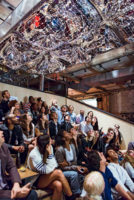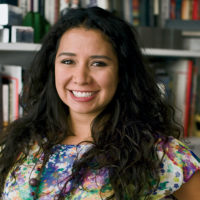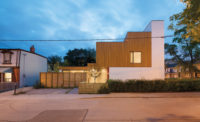Adam Marcus may count robots, 3-D printers, CNC routers, and enormous data sets as part of his typical design arsenal, but for his built work, he often returns to something as rudimentary as a pencil. In fact, one of the architect’s projects involved 8,080 of them: for an installation at the University of Minnesota’s School of Architecture called Centennial Chromograph, Marcus used polychromatic No. 2’s to fasten together a series of robotically routed wood ribs, each of which signified a year in the school’s history.
This interplay between the digital and the handmade has come to define Marcus’s sensibility since he opened his Oakland office, Variable Projects, in 2011. His creations—which he often describes as “data spatialization”—investigate how new technologies can physically (and practically) be applied to traditional architecture processes.
The architect labels Variable Projects as “post-digital,” which may sound arty and esoteric, but to Marcus signifies the contrary: making digitally designed work accessible using a human touch and simple materials. With Centennial Chromograph, for instance, viewers were invited to take pencils as souvenirs.
“I am part of a generation of architects who were educated at the height of the digital computational turn in architecture,” explains Marcus, who received his M.Arch. from Columbia in 2005. “Now we can question the naiveté of that time.”
After graduating, he spent two years in Bernard Tschumi’s office and six years at Brooklyn firm Marble Fairbanks. Then he won a two-year teaching fellowship at the University of Minnesota’s architecture school. His time in Minneapolis was productive—he began to develop Variable Projects and also formed Futures North, an art collective exploring the aesthetic possibilities of big data. One sculptural installation illustrated shifts in the contours of the Mississippi River, created by fusing data from early 19th-century maps and Google satellite images to determine the form of 15 columns. The pillars light up as information from the river is transmitted to crystalline LED lanterns on top.
Intrigued by the intersection of tech and maker culture in the Bay Area, Marcus moved in 2013 to become an assistant professor at California College of the Arts (CCA) in San Francisco. He encourages his students to have a pragmatic approach to design. “I often say to students, ‘OK, you can model it, but how do you make it?’ ” he explains. “For me, it’s about how computation can be leveraged to further architectural, social, or programmatic goals.”
A current undertaking combines digital design with ecological goals. Marcus and his studio are collaborating with biologists, Autodesk’s Pier 9 Workshop, and Kreysler & Associates (the fabricator responsible for SFMOMA’s fiber reinforced plastic [FRP] facade) on a project called Buoyant Ecologies to design synthetic habitats for marine invertebrates. Otters devoured the first critters that took to the initial FRP substrate, so the studio adjusted the geometry to protect the fledgling community. “Prototyping is important. Experiments are usually failures, but you have to get that out of the way,” he says.
The profession seems to regard him as anything but a failure. In 2013, DesignIntelligence named him one of America’s 30 Most Admired Educators. Last year, Centennial Chromograph received an AIA Small Project award. Marcus keeps his practice lean—just a few student interns—but he has a lot on his plate: he is converting a 20,000-square-foot warehouse into artists studios, further refining Buoyant Ecologies, and experimenting with algorithmically generated and parametric drawing techniques.
“I try to use the word fabrication instead of digital fabrication to bring a sense of craft into this work,” he says— “that it didn’t just come out of a 3-D printer but has the sense that a human made it.”
























Post a comment to this article
Report Abusive Comment